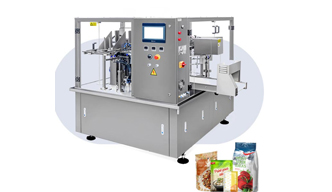
Automatic pouch packing machines are widely used in industries for their efficiency and precision. However, like any mechanical equipment, they can encounter various issues during operation. Understanding these common problems and their solutions is crucial for maintaining smooth production processes.

1. Mechanical Malfunctions
1.1 Conveyor Belt Issues
Problem: The conveyor belt may stop moving, move unevenly, or become misaligned. Stoppages can be caused by a jam due to product debris or a malfunctioning motor. Uneven movement might result from worn - out rollers or an improper tension setting. Misalignment often occurs when the belt is not installed correctly or when the guiding components are damaged.
Solution: For stoppages, first, turn off the machine and carefully remove any debris causing the jam. Check the motor for any signs of overheating or electrical problems. If the motor is faulty, it may need to be repaired or replaced. To address uneven movement, inspect and replace worn - out rollers. Adjust the tension of the conveyor belt according to the manufacturer's guidelines. In case of misalignment, realign the belt and check the guiding components. Replace any damaged parts to ensure proper tracking.
1.2 Filling Mechanism Problems
Problem: Inaccurate filling is a common issue. The fill volume may be inconsistent, either too much or too little product in each pouch. This can be due to a clogged filling nozzle, a malfunctioning filling valve, or incorrect calibration of the filling mechanism.
Solution: Regularly clean the filling nozzles to prevent clogging. Use a small brush or compressed air to remove any debris. Check the filling valves for proper operation. If the valves are damaged, replace them. Calibrate the filling mechanism periodically using standard weights or volume measurements. Follow the calibration procedure provided in the machine's manual to ensure accurate filling.
1.3 Sealing Problems
Problem: Weak or incomplete seals are frequent problems. This can lead to product leakage, reduced shelf - life, and compromised product quality. Reasons for poor sealing include dirty sealing jaws, incorrect sealing temperature or pressure settings, and worn - out sealing gaskets.
Solution: Clean the sealing jaws regularly to remove any product residues or debris. Adjust the sealing temperature and pressure according to the type of packaging material and product requirements. Refer to the machine's manual for the recommended settings. Replace the sealing gaskets at regular intervals to ensure a tight seal.
2. Electrical and Control System Issues
2.1 Electrical Failures
Problem: Electrical failures can range from blown fuses to malfunctioning control boards. A blown fuse may be caused by an electrical short circuit, overloading, or a defective component. Malfunctioning control boards can result in erratic machine operation, such as unexpected starts or stops, or incorrect control of the mechanical components.
Solution: If a fuse is blown, identify and rectify the cause of the short circuit or overloading. Replace the fuse with the correct rating. For malfunctioning control boards, first, check for any visible signs of damage, such as burnt components or loose connections. If the problem is not obvious, contact a qualified technician or the machine manufacturer for further diagnosis and repair.
2.2 Software - Related Problems
Problem: The machine's control software may encounter glitches, such as freezing, crashing, or incorrect data display. These issues can disrupt the packaging process and lead to production delays.
Solution: Regularly update the control software to the latest version provided by the manufacturer. This can often fix known bugs and improve the software's stability. If the software freezes or crashes, try restarting the machine. If the problem persists, contact the manufacturer's technical support for assistance. They may be able to provide a software patch or a solution to resolve the issue.
3. Packaging Quality Issues
3.1 Pouch Material Damage
Problem: The packaging pouches may get torn, creased, or punctured during the packing process. This can be due to rough handling by the machine's components, such as sharp edges on the conveyor belt or filling nozzles, or improper adjustment of the pouch - handling mechanisms.
Solution: Inspect the machine's components for any sharp edges or protrusions that could damage the pouches. Smooth or replace any such components. Adjust the pouch - handling mechanisms to ensure gentle and proper handling. Check the tension of the pouch - feeding system to prevent over - stretching or tearing of the pouches.
3.2 Product Contamination
Problem: Product contamination can occur if there are residues from previous batches, improper cleaning of the machine, or leaks in the filling or sealing mechanisms. This is a serious issue, especially in industries such as food and pharmaceuticals.
Solution: Implement a strict cleaning and maintenance schedule. Thoroughly clean the machine after each production run, especially the filling and sealing areas. Check for any leaks in the filling and sealing mechanisms and repair them immediately. Use appropriate cleaning agents and follow proper cleaning procedures to prevent cross - contamination.
By being aware of these common problems and their solutions, operators and maintenance personnel can quickly address issues when they arise, minimizing production downtime and ensuring the consistent quality of the packaged products. Regular maintenance, proper operation, and prompt troubleshooting are key to the reliable performance of automatic pouch packing machines.

GET A QUOTE